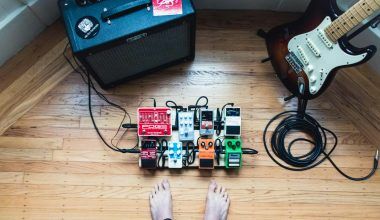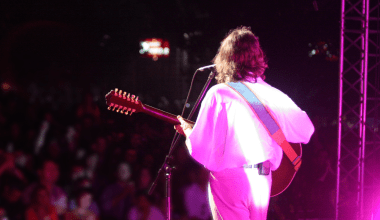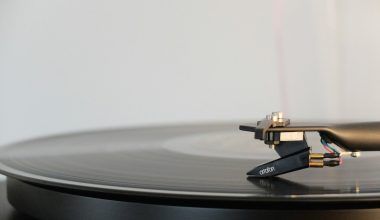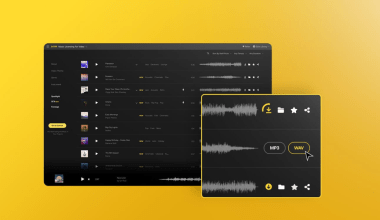Have you ever seen a singer on stage holding a mic or a drummer with a mic capturing their sound? That’s probably a dynamic microphone! A dynamic microphone is a tool that takes the sound you make and turns it into an electrical signal so it can be recorded or played through speakers.
But what makes it special? Well, it’s super tough, can handle loud sounds, and works in all kinds of noisy places. Dynamic mics are the workhorses of the music and audio world, trusted by singers, musicians, and podcasters worldwide.
How Does a Dynamic Microphone Work?
Don’t worry, it’s not rocket science! Here’s how a dynamic microphone works in very simple terms:
- Sound Hits the Mic: When you talk, sing, or play an instrument, the sound creates waves in the air.
- Diaphragm Moves: Inside the mic, there’s a thin piece of material called a diaphragm that vibrates when the sound waves hit it.
- Electricity Happens: Attached to the diaphragm is a coil that moves in a magnetic field. This movement creates an electrical signal.
- Sound Becomes Signal: This signal is sent through wires to speakers, headphones, or recording equipment.
That’s it! It’s like magic, but really, it’s just clever science.
Why Are Dynamic Microphones So Popular?
Dynamic microphones are loved for many reasons:
- Strong and Durable: These mics can take a fall or handle rough use and still work perfectly.
- Great for Loud Sounds: They don’t distort even if someone is shouting or if a drum is super loud.
- No Extra Power Needed: They work right out of the box without needing batteries or special power.
- Affordable: You don’t need to spend a fortune to get a great dynamic mic.
Because of all this, they’re a favorite for live shows, band practice, and even recording in a home studio.
Dynamic Microphones in Everyday Life
Here’s where you might see or use a dynamic mic:
- On Stage: Singers, comedians, and public speakers often use handheld dynamic mics during live performances.
- Recording Music: If you’re recording loud instruments like drums or electric guitars, a dynamic mic is your best friend.
- Podcasts and Videos: Many podcasters use dynamic microphones because they block out background noise.
- Broadcasting: Radio and TV hosts use dynamic mics for their crisp sound.
Dynamic Microphone vs. Condenser Microphone
If you’re confused about the difference between dynamic and condenser mics, here’s a simple comparison:
| Feature | Dynamic Microphone | Condenser Microphone |
|---|---|---|
| Strength | Tough and long-lasting | Fragile, needs careful handling |
| Power Requirement | No extra power needed | Needs phantom power or batteries |
| Best Use | Loud sounds, live shows | Studio recordings, soft vocals |
| Price | Budget-friendly | More expensive |
| Sound Quality | Warm and natural | Detailed and sensitive |
How to Use a Dynamic Microphone?
Using a dynamic mic is super simple! Here’s what you do:
- Plug It In: Connect it to a sound system, mixer, or audio interface.
- Position It Well: Keep it close to your mouth or instrument for the best sound.
- Speak or Play Clearly: Let the mic do its job. It won’t pick up too much background noise, so just focus on your sound.
- Avoid Handling Noise: Hold it steady to avoid extra noise from movement.
Different Types of Dynamic Microphones
Dynamic microphones come in various shapes and sizes. Here are a few common types:
- Handheld Microphones: Perfect for singers and speakers.
- Instrument Microphones: Designed to capture specific instruments like drums or guitars.
- Broadcast Microphones: Used by radio hosts for clear speech.
Famous Dynamic Microphones You Should Know
Some dynamic microphones have become legends in the audio world. For example:
- Shure SM58: A favorite for live vocals.
- Shure SM57: Great for recording instruments like drums or guitars.
- Electro-Voice RE20: Loved by radio broadcasters for its smooth sound.
Who Should Use a Dynamic Microphone?
Dynamic microphones are for everyone! Whether you’re a beginner, a pro, or just someone who loves music or podcasting, you can use one. Here’s why:
- Singers: Dynamic mics are great for live singing because they capture your voice without picking up background noise.
- Musicians: Drummers, guitarists, and even brass players use these mics to record or amplify their sound.
- For Podcasters: Dynamic mics make your voice sound clean and block out room noise.
- For Kids: Yes, even kids can use them to sing karaoke or practice speeches!
Maintaining Your Dynamic Microphone
Taking care of your mic is easy:
- Keep It Clean: Wipe it down after use. Dust can affect its performance.
- Store Safely: Always keep your mic in a protective case when not in use.
- Avoid Dropping: While they’re tough, too many drops can eventually cause damage.
Myths About Dynamic Microphones
Let’s clear up some common myths:
- “Dynamic mics are old-fashioned.” No way! They’re still used in top concerts and studios.
- “They can’t capture small details.” Many modern dynamic mics are excellent at picking up subtle sounds.
- “They’re only for professionals.” Anyone can use a dynamic mic—no special training needed!
The History of Dynamic Microphones
Dynamic microphones have been around for decades. The first versions were created in the early 20th century and have since evolved to include advanced features. They’ve been used in everything from old radio broadcasts to modern-day concerts.
Conclusion: Why Should You Get a Dynamic Microphone?
If you need a microphone that’s easy to use, tough as nails, and works in almost any situation, a dynamic microphone is a great choice. Whether you’re singing your heart out on stage, recording your first podcast, or jamming with your band, a dynamic mic will never let you down.
So, what are you waiting for? Grab your dynamic microphone and start creating amazing sound today!
Related Articles:
For further reading, explore these related articles:
- How to Become a Successful Music Artist in India in 2024?
- Promo Cards on Spotify: A Game Changer for Artists
For additional resources on music marketing and distribution, visit Deliver My Tune.






